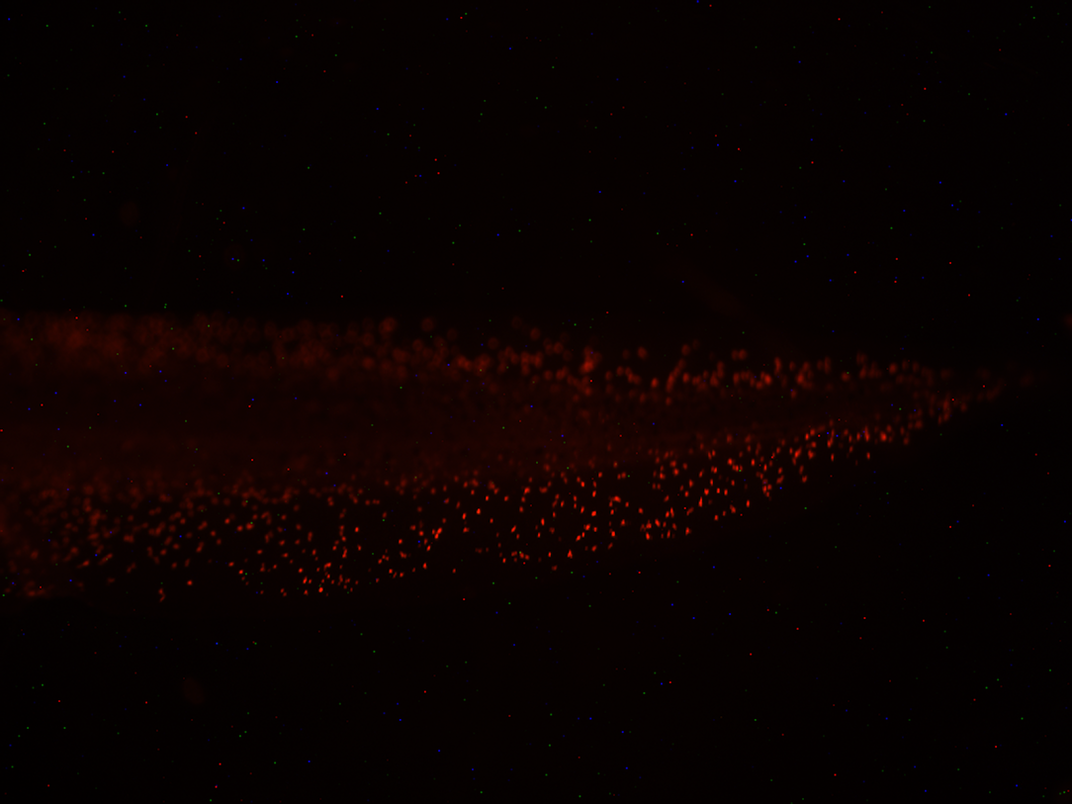Tweaking the Tiny Electrical Charges Inside Cells Can Fight Infection
It works in tadpoles. Could it work in humans?
/https://tf-cmsv2-smithsonianmag-media.s3.amazonaws.com/filer/e6/3e/e63e30a0-b7bd-4000-812a-e62024c27be7/tadpoles_-_agalychnis_callidryas_cutted.png)
Most of us know that neurons and other cells within the nervous system use electricity to communicate. But what scientists have learned in recent decades is that all cells in the body do this, using electricity to “talk” to each other and make decisions about growth and development.
Now, researchers at Tufts University have discovered that manipulating the electrical charge of cells can increase an organism’s ability to fight infection. While the research was on tadpole embryos, if the phenomenon holds true in humans it could be a new way to combat disease. It also has the potential to lead to new ways of repairing injuries, even, one day, helping regenerate body parts.
“Bioelectricity is an amazing new direction in medicine that goes far beyond just infection,” says Michael Levin, a professor of biology at Tufts who led the research.
Every cell in a living body contains a tiny electric charge, defined as the difference between charged atoms on either side of the cell’s membrane. Levin, who has been studying these charges for years, hypothesized that depolarizing the cells—reducing the difference in charge between the inside and outside of the cell—could help a body fight off infection.
In the study, which was published today in npj Regenerative Medicine, the researchers used drugs to depolarize the cells of tadpole embryos. They then infected the embryos with E. coli. While 50 to 70 percent of ordinary tadpoles infected with E. coli died, only 32 percent of the tadpoles with depolarized cells did.
But the researchers still needed to make sure that drugs were actually changing the tadpoles’ cells’ electrical charges, not just killing the E. coli directly. So they injected tadpole cells with messenger RNA (mRNA) encoded with information to depolarize the tadpoles’ cells directly. This approach worked similarly to the drug treatment, suggesting it’s the depolarization and not the drugs that fight infection.
“The effect was not on the bacteria, it was on the host,” Levin says.
There are two types of immune systems present in all vertebrates, from tadpoles to humans. There’s the adaptive immune system, which works by being exposed to a specific pathogen. After you get a vaccine, the adaptive immune system “remembers” the pathogen and can fight against it if you’re exposed again. The same goes for if you’re exposed to a pathogen in the wild, like if you catch chicken pox. The adaptive immune system knows how to fight it, so you’re far less likely to ever catch it again. But the adaptive immune system only works on pathogens it recognizes, so it can’t help if you’re exposed to something completely new. Then there’s the innate immune system, which develops in your earliest moments as a fertilized egg. It attacks any pathogen using special blood cells and chemical mediators.
The depolarization works with the innate immune system, helping it marshal more of the forces, such as macrophages (a type of infection-fighting white blood cell), necessary to fight infection. It's not yet clear why this works, but it likely has something to do with manipulating the pathways used to communicate with the innate immune system.
It’s also known that the innate immune system also helps organisms regenerate and repair tissues. Levin and his team knew that tadpoles that have their tails amputated show depolarization in their cells. So putting the clues together, they wondered if injured tadpoles would therefore be able to fight infection better. So they amputated tadpoles’ tails and infected them with E. coli. Those tadpoles were, in fact, better able to fight off the infection.


But will this bioelectricity manipulation technique work on humans?
“The main technology that we use, which is to use drugs and also ion channel mRNA to depolarize those cells, that can be used in any creature,” Levin says. “In fact we’ve done it in organisms including human cells.”
Some of the drugs that can be used to depolarize cells are already approved for humans. They include anti-parasitics and drugs for heart arrhythmias and seizures. Levin calls these drugs “ionoceutics,” as they change the cell’s polarization.
The team is moving onto rodent models. If that’s successful, human testing could be down the road.
But there may be challenges in applying a method that works on embryonic tadpoles to one that works on non-embryonic animals. The pathways present during embryonic development that allow the cells to be depolarized and activate the immune system may not be present after birth.
“Whether or not we can reactive them without adverse effects in unknown,” says Jean-François Paré, a research associate in Levin’s lab and the first author on the paper.
In addition to studying depolarization’s effects on infection, Levin’s lab also looks at how manipulating bioelectricity can help fight cancer, repair birth defects and even regenerate organs or limbs. The team hypothesizes that it's possible to alter the way cells electrically communicate their decisions about growth and development, steering them into "deciding" to regrow, say, a lost finger.
“We’re working on enhancing regenerative ability,” Levin says. “Ultimately the goal is to be able to regenerate any organ that’s been damaged. It sounds like sci-fi, but at some point we’re going to be able to grow these things back.”
/https://tf-cmsv2-smithsonianmag-media.s3.amazonaws.com/accounts/headshot/matchar.png)
/https://tf-cmsv2-smithsonianmag-media.s3.amazonaws.com/accounts/headshot/matchar.png)